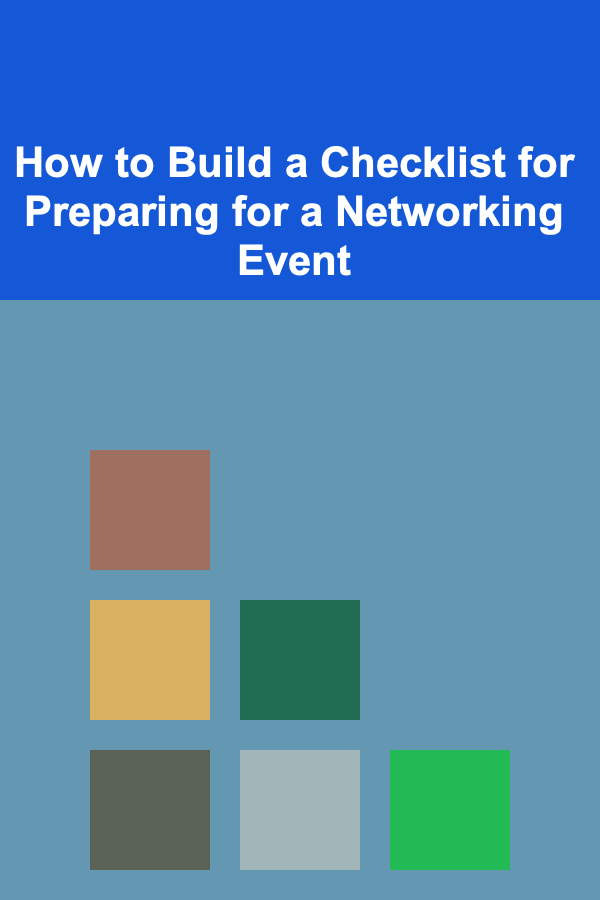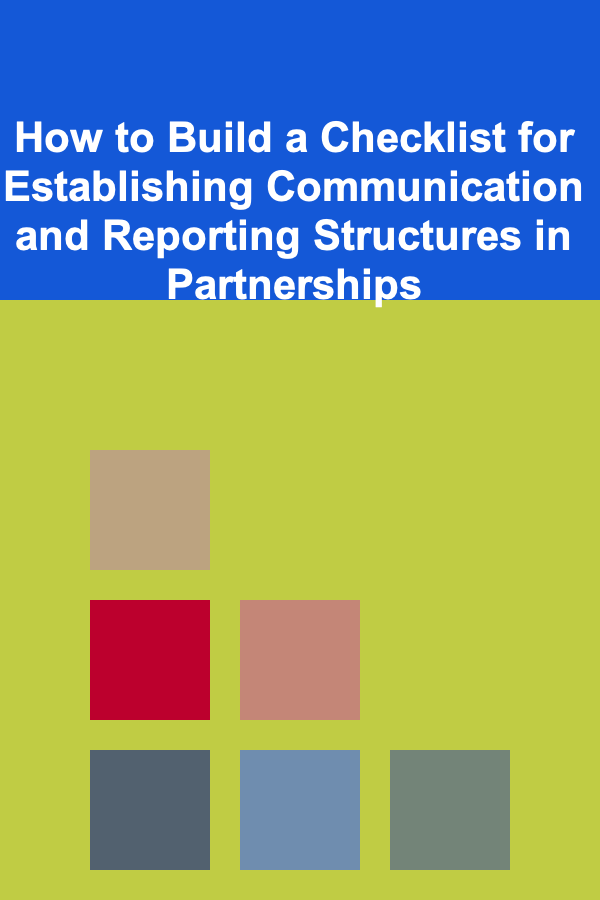
How to Build a Checklist for Preparing for a Networking Event
ebook include PDF & Audio bundle (Micro Guide)
$12.99$7.99
Limited Time Offer! Order within the next:

Networking events are powerful opportunities for professionals to meet potential clients, partners, and collaborators. Whether you're attending a local event or a major industry conference, preparation is key to making the most of your time and building valuable connections. A well-crafted checklist can help you stay organized and ensure that you're ready for the event both mentally and practically.
In this actionable guide, we'll walk you through how to build a checklist for preparing for a networking event. This checklist will cover everything from researching the event and setting goals to post-event follow-ups, ensuring that you're fully prepared to make a meaningful impact.
Define Your Networking Goals
Before you dive into logistical preparations, it's essential to define your objectives for attending the networking event. Without clear goals, it's easy to get lost in the crowd and miss out on opportunities that matter most to you.
Key Questions:
- What do you want to achieve at this event? Are you looking to expand your client base, find potential business partners, or learn from industry experts?
- Who do you want to meet? Make a list of key individuals or types of professionals you would like to connect with. This could include potential clients, competitors, influencers, or mentors.
- How many connections do you aim to make? Setting a specific number of meaningful interactions can help you stay focused and purposeful throughout the event.
By defining these goals, you can tailor your approach to the event and ensure that every interaction moves you closer to achieving your objectives.
Research the Event and Its Attendees
One of the best ways to prepare for a networking event is to research it thoroughly. Knowing the schedule, the speakers, the themes, and the attendees can help you plan your strategy for maximizing your time and energy.
Steps for Research:
- Check the Event Schedule: Understand the flow of the event. Are there specific sessions, workshops, or keynote speakers that align with your goals? Plan your time accordingly so you don't miss valuable content.
- Review the List of Attendees: Many events publish a list of attendees, either before or after registration. Look through the list and identify individuals or companies you want to approach. This gives you a head start in identifying potential connections and making your introduction more personalized.
- Research Speakers and Panelists: If there are notable industry leaders or experts speaking at the event, take some time to familiarize yourself with their background and work. Knowing their current projects or challenges can give you useful conversation starters.
- Identify Networking Opportunities: Check if the event offers structured networking opportunities like speed networking, meet-and-greets, or workshops. These can be useful for meeting a large number of people in a short time.
Prepare Your Personal Pitch
Your personal pitch is crucial when attending a networking event. It's your elevator pitch, a brief introduction that summarizes who you are, what you do, and what value you bring to the table. A strong pitch helps you stand out in a crowded room and initiates meaningful conversations.
Key Elements of a Personal Pitch:
- Who You Are: Start with your name and your role. Keep it concise, but confident.
- What You Do: Briefly explain your profession, area of expertise, or your business.
- Why You're at the Event: Tailor your pitch to the event. Are you looking for potential collaborations, seeking mentorship, or aiming to grow your client base?
- Call to Action: End with an invitation to continue the conversation. For instance, "I'd love to connect over coffee later to explore potential synergies."
Tip:
Keep your pitch under 30 seconds. Practice it until it feels natural and doesn't sound rehearsed. You should be able to deliver it confidently in any situation.
Update Your Online Profiles
Before heading to the event, make sure your online profiles, particularly LinkedIn, are up-to-date. Networking doesn't just happen face-to-face---it often continues after the event, with connections made online.
Profile Updates to Consider:
- LinkedIn Headline and Summary: Ensure your headline clearly conveys what you do and what value you offer. Your summary should be engaging and reflective of your professional goals, not just your past experiences.
- Recent Work and Achievements: If applicable, update your work experience, skills, or achievements. Having your most recent projects or accomplishments listed will allow you to reference them during conversations and increase your credibility.
- Profile Picture: Make sure your photo is professional, approachable, and current. A good photo can make a significant first impression, especially if you're meeting people who might search for you online after the event.
Tip:
Don't just update your profile before the event---engage with others. Share relevant content, comment on posts, or engage with the event's official social media accounts to build rapport before you even meet.
Bring the Right Materials
When attending a networking event, always come prepared with the right materials. Being organized and ready for spontaneous interactions shows professionalism and makes a great impression.
Items to Bring:
- Business Cards: These are still one of the most effective tools for networking. Even in the digital age, a well-designed business card can be a tangible reminder of your interaction. Bring enough to last the entire event, but don't overload your pockets.
- Event Materials: If the event provides brochures, agendas, or any materials in advance, print them out or have them available on your phone or tablet. Having a printed agenda can also help you manage your time effectively during the event.
- Notebook and Pen: It's always a good idea to have a notebook to jot down important details from your conversations. This helps you remember specifics about the people you meet, allowing for more personalized follow-up.
- Phone Charger or Power Bank: Networking events can be long, and you'll likely use your phone for various tasks throughout the day. Make sure you have a charger or power bank to stay connected.
Tip:
Consider having a digital version of your business card via a professional app, such as LinkedIn or a business card exchange app, for quick and easy sharing.
Plan Your Time Wisely
A major networking event can be overwhelming due to the sheer number of people and sessions. To avoid feeling scattered, plan your time wisely.
Tips for Time Management:
- Prioritize Sessions: Focus on the sessions that will help you achieve your goals. You don't need to attend every session---select the ones that will provide the most value to your objectives.
- Schedule Breaks: Networking can be exhausting. Take breaks between sessions to recharge, review your notes, or follow up on any immediate actions (such as connecting on LinkedIn).
- Set Networking Goals: Set a target for how many people you aim to connect with during each session or at breaks. This keeps you focused and ensures you're actively networking.
- Don't Overbook Yourself: If you're scheduling one-on-one meetings or follow-up coffees during the event, leave enough time between them. Overloading your schedule can lead to burnout.
Be Ready for Follow-Up After the Event
The networking event doesn't end when you walk out the door. The follow-up is just as important as the initial connection. Make it a priority to reach out to those you met, while your interaction is still fresh in their minds.
Key Follow-Up Steps:
- Send Personalized LinkedIn Connection Requests: When you connect with someone on LinkedIn, include a brief personalized message reminding them of your interaction. This increases the chance that they'll accept your request.
- Send Thank-You Emails: If you had a meaningful conversation with someone, send a follow-up email expressing gratitude for their time and the insights they shared. Mention specific points from your conversation to make the email feel personalized.
- Schedule a Follow-Up Meeting: If you discussed potential collaborations or next steps, set up a follow-up meeting within a week of the event to keep the momentum going.
Tip:
Do not delay your follow-up. People often forget the details of networking events if the follow-up is too late. Try to reach out within 48 hours.
Conclusion
Attending a networking event can be an incredibly rewarding experience, but success requires preparation. By using this checklist, you can ensure that you approach the event with a clear plan, make meaningful connections, and follow up effectively to nurture your relationships.
By taking the time to set goals, research the event, prepare your personal pitch, and equip yourself with the right materials, you will be ready to network confidently and productively. And remember, networking is not just about collecting business cards; it's about building authentic relationships that can last beyond the event.
Reading More From Our Other Websites
- [Scrapbooking Tip 101] Must-Have Memorabilia: What to Include in Every Baby Scrapbook
- [Home Holiday Decoration 101] How to Style Your Holiday Tree with Non-Traditional Color Schemes
- [Organization Tip 101] How to Organize Your Craft Room with Multi-Functional Furniture
- [Personal Care Tips 101] How to Select a Face Serum for Skin Firming and Tightening
- [Organization Tip 101] What Are the Benefits of Organizing Your Cleaning Routines?
- [Organization Tip 101] How to Create a Memory Book for Seniors
- [Personal Care Tips 101] How to Stay Positive During a Health Challenge
- [Home Holiday Decoration 101] How to Create a Holiday-Themed Entryway That Impresses Guests
- [Personal Care Tips 101] How to Integrate the Best Hair Masks into Your Weekly Routine for Maximum Shine and Strength
- [Home Maintenance 101] How to Extend the Life of Your Roof with Proper Maintenance

How to Build a Checklist for Establishing Communication and Reporting Structures in Partnerships
Read More
How to Create a Floor Plan for Your New Home
Read More
How to Sell Your Old Vinyl Records at a Garage Sale: A Step-by-Step Guide
Read More
How to Stage a Historic Home with Modern Touches
Read More
How to Plan a Fitness Class Around Specific Music Genres
Read More
How to Choose the Right Contractor: A Renovation Checklist
Read MoreOther Products

How to Build a Checklist for Establishing Communication and Reporting Structures in Partnerships
Read More
How to Create a Floor Plan for Your New Home
Read More
How to Sell Your Old Vinyl Records at a Garage Sale: A Step-by-Step Guide
Read More
How to Stage a Historic Home with Modern Touches
Read More
How to Plan a Fitness Class Around Specific Music Genres
Read More